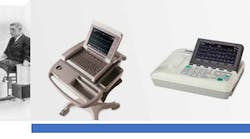The Low-Power Mantra Rings Louder with Next-Gen Medical Wearables (.PDF Download)
Fitness bands that monitor and track heart rate, breathing, activity, and other fitness-related data are now everyday consumer items, but they’re only the most visible piece of the larger wearable health, fitness, and medical segment. Now wearable devices are beginning to transform medical care in both the hospital and the home, helping to reduce costs, increasing patient involvement in their own care, providing round-the-clock monitoring, and even administering medications based on a preset schedule.
Wearable medical devices can monitor a broad range of clinical measurements: heart rate and breathing, as well as diagnostic indicators like oxygen level, glucose levels, hydration, blood pressure, skin conductance, temperature, brain activity, and many more. The data is then logged and communicated wirelessly to the medical staff, who have a permanent record and early warning of potential problems.
1. Like many other medical monitoring technologies, the ECG has progressed from an expensive fixed-base machine to a low-cost wearable appliance. (Source: TI “Advances in bio-inspired sensing help people lead healthier lives” PDF)
The transition from a cumbersome fixed-base installation to a tiny module that the patient barely notices has been a long time coming (Fig. 1). For example, when the first electrocardiography (ECG) machine appeared in 1908, it required five people to operate and the patient had to place each limb in a bucket of salt water. Still, that was a vast improvement over what had gone before: Until the late 1800s, medical scientists could only record heart activity by directly examining the heart. Of course, its owner had to be dead, but still….
Current-generation medical wearables do much more than just monitor the patient’s heartbeat. They combine multiple functions into a single biosensor. VitalConnect’s clinical-grade VitalPatch, for example, contains ECG electrodes, a three-axis MEMS accelerometer, and a thermistor. In addition to heart rate, the patch provides real-time monitoring of respiratory rate, skin temperature, and metrics such as body posture, activity level, and fall detection. Hospital staff can access the information via web-enabled devices on the hospital network.

